Next  came
the rebellious upstart Yankees who wanted to rule themselves. Had
it not been for the overwhelming defensive character of the
fort's design, Nova Scotia very well may have been among the
first American States. After the ashes settled, the money ran out
and the rust settled in. Then it was 1812 and England and the
U.S. ran out of words and took up arms. Again, the Citadel
reverberated with the sound of new construction and new guns.
Bigger and better guns with rifled barrels, capable of accurate
shot for several miles. Still there were no assaulters willing to
take on the continuingly advancing design of one of the most
fortified structures of its size. Now, fortifications up to and
until their demise around the end of WWII were based
came
the rebellious upstart Yankees who wanted to rule themselves. Had
it not been for the overwhelming defensive character of the
fort's design, Nova Scotia very well may have been among the
first American States. After the ashes settled, the money ran out
and the rust settled in. Then it was 1812 and England and the
U.S. ran out of words and took up arms. Again, the Citadel
reverberated with the sound of new construction and new guns.
Bigger and better guns with rifled barrels, capable of accurate
shot for several miles. Still there were no assaulters willing to
take on the continuingly advancing design of one of the most
fortified structures of its size. Now, fortifications up to and
until their demise around the end of WWII were based 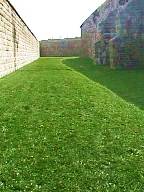 on simple tried and true principles which up until
then had never failed. From the Alamo to the Citadel, these
principals remained the same. The high impenatrabile wall. The
counter to this was of course the penetrating cannon shot. The
action was called a "breach". Cannonballs were fired at
the same place on a wall until a hole was knocked through the
wall allowing assault troops to run through it and engage the
defenders, and finally nutrilize the fort. The only other way was
a far more courageous method. To scale the walls and overrun the
defense. Failing either of these methods, the last remaining is
siege, the slow monotonous ineffective shelling of unoccupied
areas for a period sufficient to deprive the
on simple tried and true principles which up until
then had never failed. From the Alamo to the Citadel, these
principals remained the same. The high impenatrabile wall. The
counter to this was of course the penetrating cannon shot. The
action was called a "breach". Cannonballs were fired at
the same place on a wall until a hole was knocked through the
wall allowing assault troops to run through it and engage the
defenders, and finally nutrilize the fort. The only other way was
a far more courageous method. To scale the walls and overrun the
defense. Failing either of these methods, the last remaining is
siege, the slow monotonous ineffective shelling of unoccupied
areas for a period sufficient to deprive the 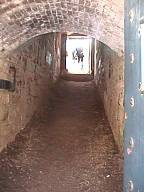 defenders
of food or water until they give up or die. Eliminating all but
the last of these approaches was accomplished in the earthen
design, which became the standard for fortifications from that
point on until eliminated. The very top of the fortification was
built flush with the top of the hill, thus the walls were not in
the line of fire for any cannons firing from below. A solid wall
of from 10 to 16 feet was built in the hollowed out center of the
hill, preventing access to the insides. The line of fire from the
Fort was directly down the long hill leading to the bottom and
was covered with short grass, affording no place to hide for
advancing troops. The dividing pit was connected to the inside by
a narrow corridor which was easily defended. The walls built up
from the bottom of the pit were actually rooms which housed the
soldiers who lived inside. Many of these
defenders
of food or water until they give up or die. Eliminating all but
the last of these approaches was accomplished in the earthen
design, which became the standard for fortifications from that
point on until eliminated. The very top of the fortification was
built flush with the top of the hill, thus the walls were not in
the line of fire for any cannons firing from below. A solid wall
of from 10 to 16 feet was built in the hollowed out center of the
hill, preventing access to the insides. The line of fire from the
Fort was directly down the long hill leading to the bottom and
was covered with short grass, affording no place to hide for
advancing troops. The dividing pit was connected to the inside by
a narrow corridor which was easily defended. The walls built up
from the bottom of the pit were actually rooms which housed the
soldiers who lived inside. Many of these 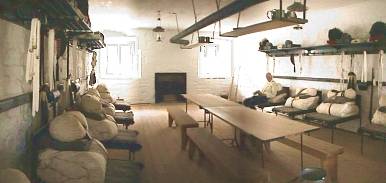 rooms have been re-created to reflect
their use in the 1800s. One was the enlisted men's barracks Each
barrack room was equipped according to regulations with
standardized government issued furniture and outfitting. Each
occupied bed had a small tin label holder. The soldier's name and
rank was inserted into the holder. When flipped over the label
read "DUTY" which indicated the soldier was away for a
period of time. Until 1825 the soldier's bed had been a wooden
bunk. It was replaced by a folding iron bed at that time. Each
bed was
rooms have been re-created to reflect
their use in the 1800s. One was the enlisted men's barracks Each
barrack room was equipped according to regulations with
standardized government issued furniture and outfitting. Each
occupied bed had a small tin label holder. The soldier's name and
rank was inserted into the holder. When flipped over the label
read "DUTY" which indicated the soldier was away for a
period of time. Until 1825 the soldier's bed had been a wooden
bunk. It was replaced by a folding iron bed at that time. Each
bed was 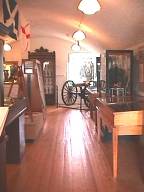 allotted two gray barrack blankets.
The bolster is a pillow. Prior to 1861, the stuffing was straw
but after that date horsehair was used. A form is a bench. The
standard military pattern was made of pine and was six feet long
to seat four men. Some of the rooms were used as a museum for
items that played a part in the development of the British
military and later Canadian defense. One example was an original
model of the first truly automatic or machine gun. The revolving
barreled guns of Dr. Richard Gatling's patents saw world wide
service from the battlefield of the American Civil War to the
Bolshevik Revolution. Gatling's hand cranked design was made
obsolete by the advent of smokeless power and the resulting
gas-operated machine guns of Sir Hiram Maxim and John Browning.
There were many other things that I could have commented on but
it would make the article go on for quite a while. This is an
important point in Halifax and definitely worth while to explore.
Guided tours are available and are an added attraction.
allotted two gray barrack blankets.
The bolster is a pillow. Prior to 1861, the stuffing was straw
but after that date horsehair was used. A form is a bench. The
standard military pattern was made of pine and was six feet long
to seat four men. Some of the rooms were used as a museum for
items that played a part in the development of the British
military and later Canadian defense. One example was an original
model of the first truly automatic or machine gun. The revolving
barreled guns of Dr. Richard Gatling's patents saw world wide
service from the battlefield of the American Civil War to the
Bolshevik Revolution. Gatling's hand cranked design was made
obsolete by the advent of smokeless power and the resulting
gas-operated machine guns of Sir Hiram Maxim and John Browning.
There were many other things that I could have commented on but
it would make the article go on for quite a while. This is an
important point in Halifax and definitely worth while to explore.
Guided tours are available and are an added attraction.
*** THE
END***

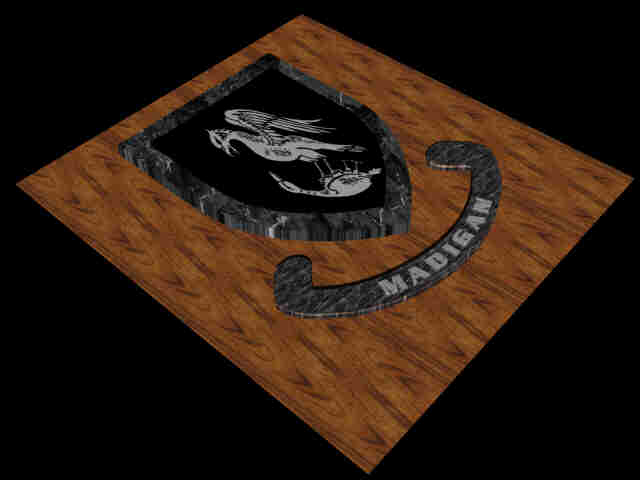 <<<<< Back
Next >>>>>
<<<<< Back
Next >>>>> 
 came
the rebellious upstart Yankees who wanted to rule themselves. Had
it not been for the overwhelming defensive character of the
fort's design, Nova Scotia very well may have been among the
first American States. After the ashes settled, the money ran out
and the rust settled in. Then it was 1812 and England and the
U.S. ran out of words and took up arms. Again, the Citadel
reverberated with the sound of new construction and new guns.
Bigger and better guns with rifled barrels, capable of accurate
shot for several miles. Still there were no assaulters willing to
take on the continuingly advancing design of one of the most
fortified structures of its size. Now, fortifications up to and
until their demise around the end of WWII were based
came
the rebellious upstart Yankees who wanted to rule themselves. Had
it not been for the overwhelming defensive character of the
fort's design, Nova Scotia very well may have been among the
first American States. After the ashes settled, the money ran out
and the rust settled in. Then it was 1812 and England and the
U.S. ran out of words and took up arms. Again, the Citadel
reverberated with the sound of new construction and new guns.
Bigger and better guns with rifled barrels, capable of accurate
shot for several miles. Still there were no assaulters willing to
take on the continuingly advancing design of one of the most
fortified structures of its size. Now, fortifications up to and
until their demise around the end of WWII were based  on simple tried and true principles which up until
then had never failed. From the Alamo to the Citadel, these
principals remained the same. The high impenatrabile wall. The
counter to this was of course the penetrating cannon shot. The
action was called a "breach". Cannonballs were fired at
the same place on a wall until a hole was knocked through the
wall allowing assault troops to run through it and engage the
defenders, and finally nutrilize the fort. The only other way was
a far more courageous method. To scale the walls and overrun the
defense. Failing either of these methods, the last remaining is
siege, the slow monotonous ineffective shelling of unoccupied
areas for a period sufficient to deprive the
on simple tried and true principles which up until
then had never failed. From the Alamo to the Citadel, these
principals remained the same. The high impenatrabile wall. The
counter to this was of course the penetrating cannon shot. The
action was called a "breach". Cannonballs were fired at
the same place on a wall until a hole was knocked through the
wall allowing assault troops to run through it and engage the
defenders, and finally nutrilize the fort. The only other way was
a far more courageous method. To scale the walls and overrun the
defense. Failing either of these methods, the last remaining is
siege, the slow monotonous ineffective shelling of unoccupied
areas for a period sufficient to deprive the  defenders
of food or water until they give up or die. Eliminating all but
the last of these approaches was accomplished in the earthen
design, which became the standard for fortifications from that
point on until eliminated. The very top of the fortification was
built flush with the top of the hill, thus the walls were not in
the line of fire for any cannons firing from below. A solid wall
of from 10 to 16 feet was built in the hollowed out center of the
hill, preventing access to the insides. The line of fire from the
Fort was directly down the long hill leading to the bottom and
was covered with short grass, affording no place to hide for
advancing troops. The dividing pit was connected to the inside by
a narrow corridor which was easily defended. The walls built up
from the bottom of the pit were actually rooms which housed the
soldiers who lived inside. Many of these
defenders
of food or water until they give up or die. Eliminating all but
the last of these approaches was accomplished in the earthen
design, which became the standard for fortifications from that
point on until eliminated. The very top of the fortification was
built flush with the top of the hill, thus the walls were not in
the line of fire for any cannons firing from below. A solid wall
of from 10 to 16 feet was built in the hollowed out center of the
hill, preventing access to the insides. The line of fire from the
Fort was directly down the long hill leading to the bottom and
was covered with short grass, affording no place to hide for
advancing troops. The dividing pit was connected to the inside by
a narrow corridor which was easily defended. The walls built up
from the bottom of the pit were actually rooms which housed the
soldiers who lived inside. Many of these  rooms have been re-created to reflect
their use in the 1800s. One was the enlisted men's barracks Each
barrack room was equipped according to regulations with
standardized government issued furniture and outfitting. Each
occupied bed had a small tin label holder. The soldier's name and
rank was inserted into the holder. When flipped over the label
read "DUTY" which indicated the soldier was away for a
period of time. Until 1825 the soldier's bed had been a wooden
bunk. It was replaced by a folding iron bed at that time. Each
bed was
rooms have been re-created to reflect
their use in the 1800s. One was the enlisted men's barracks Each
barrack room was equipped according to regulations with
standardized government issued furniture and outfitting. Each
occupied bed had a small tin label holder. The soldier's name and
rank was inserted into the holder. When flipped over the label
read "DUTY" which indicated the soldier was away for a
period of time. Until 1825 the soldier's bed had been a wooden
bunk. It was replaced by a folding iron bed at that time. Each
bed was  allotted two gray barrack blankets.
The bolster is a pillow. Prior to 1861, the stuffing was straw
but after that date horsehair was used. A form is a bench. The
standard military pattern was made of pine and was six feet long
to seat four men. Some of the rooms were used as a museum for
items that played a part in the development of the British
military and later Canadian defense. One example was an original
model of the first truly automatic or machine gun. The revolving
barreled guns of Dr. Richard Gatling's patents saw world wide
service from the battlefield of the American Civil War to the
Bolshevik Revolution. Gatling's hand cranked design was made
obsolete by the advent of smokeless power and the resulting
gas-operated machine guns of Sir Hiram Maxim and John Browning.
There were many other things that I could have commented on but
it would make the article go on for quite a while. This is an
important point in Halifax and definitely worth while to explore.
Guided tours are available and are an added attraction.
allotted two gray barrack blankets.
The bolster is a pillow. Prior to 1861, the stuffing was straw
but after that date horsehair was used. A form is a bench. The
standard military pattern was made of pine and was six feet long
to seat four men. Some of the rooms were used as a museum for
items that played a part in the development of the British
military and later Canadian defense. One example was an original
model of the first truly automatic or machine gun. The revolving
barreled guns of Dr. Richard Gatling's patents saw world wide
service from the battlefield of the American Civil War to the
Bolshevik Revolution. Gatling's hand cranked design was made
obsolete by the advent of smokeless power and the resulting
gas-operated machine guns of Sir Hiram Maxim and John Browning.
There were many other things that I could have commented on but
it would make the article go on for quite a while. This is an
important point in Halifax and definitely worth while to explore.
Guided tours are available and are an added attraction.
